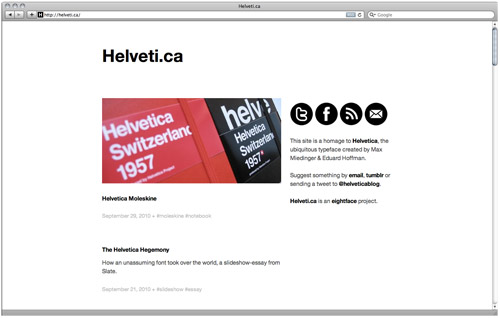The recent episode of the The Simpsons featured a couch-gag from Banksy. The New York Times has an interview with Al Jean explaining the “button-pushing” and offering some details about the opening. For those of us not in the US, poke around the internet a bit, you should be able to find a copy of the video. The Guardian also has a description of the intro.
Map of Online Communities

Randall from xkcd has posted an updated version of the Map of Online Communities for 2010. It’s also available full size for extra goodness.
ATypI 2010 Keynote
Yves Peters reports on the ATypI 2010 Keynote presentation in Dublin, featuring Robert Bringhurst. Noted for the using my photograph of The Elements of Typographic Style.
Time-lapse book cover design
A two minute time-lapse video of a book cover being designed. Lauren Panepinto, the creative director of Orbit Books, lets you see the process behind creating the cover for Blameless by Gail Carriger. You can read Laura’s blog post about the video to glean a few more details about the process.
Over 6 hours of my onscreen compositing, retouching, color correction, type obsessing, all condensed down to a slim sexy one minute 55 seconds of cover design. Trust me, no one wants to watch it in real-time.
Lastly, design:related has a few more details about the cover, including one of the early comps from the series.
GBV Database

The Guided By Voices Database has everything you need to know about the band’s discography, as well as the various side projects that Pollard and crew are involved with.
This site allows you to navigate & search the Guided By Voices discography and gigography. Information includes catalog numbers, scanned album images, track times, credits, vinyl color, pressing information, release dates, setlists, and gig ticket/poster images. Song details include the releases the song appears on and gigs where the track was played live.
I found a copy of the setlist from one of two back-to-back shows that I went to at the Horseshoe Tavern years ago. Both nights were epic, featuring three hour sets with double encore.
Original Marble and Granite Co.

The Original Marble & Granite Co. Ltd. is based out of Hoddesdon in Hertfordshire. They don’t have a website and are probably not aware of the sheer internet greatness of their name.
The photo was taken with my crappy phone camera on the way home for work the other day.
Update: Actually, I think this might be their website.
Fake money saved Brazil
How Fake Money Saved Brazil examines how the country dealt with runaway inflation.
“We called it a Unit of Real Value — URV,” Bacha says. “It was virtual; it didn’t exist in fact.” People would still have and use the existing currency, the cruzeiro. But everything would be listed in URVs, the fake currency. Their wages would be listed in URVs. Taxes were in URVs. All prices were listed in URVs. And URVs were kept stable — what changed was how many cruzeiros each URV was worth.
Still, people used URVs. And after a few months, they began to see that prices in URVs were stable. Once that happened, Bacha and his buddies could declare that the virtual currency would become the country’s actual currency. It would be called the real.
Tuning Canabalt

The developer behind Canabalt has written an article about tuning the game to achieve the feel that players expect. The post includes details about the selection of aspect ratio, the hitbox and the player’s motion. If you don’t own it already, the game is a fun one to have around on your iOS device when you need to kill a few minutes.
HelvetiNote for the iPad.
HelvetiNote for the iPad.
Helveti.ca
I bought the domain Helveti.ca about four years ago, and had a weblog there for a few months. There was a mixup with hosting, the site was deleted and there was no backup. After languishing for awhile, I revived the site earlier this year and put up a tumblelog.
Obviously, the site is a homage to Helvetica, the ubiquitous typeface created by Max Miedinger & Eduard Hoffman. I try to avoid posting anything that just happens to use Helvetica. Opting instead for artwork, articles, videos, etc. that directly reference the typeface in one form or another.
Stop by and have a look around. Subscribe to the RSS feed or follow @helveticablog on Twitter to keep up to date.
Little houses
In Japan, Living Large in Really Tiny Houses takes a look at Japanese micro homes.
“If you tried to build a normal house on a super-small plot of land, it would end up being really cramped. So in order to make the house as roomy as possible, we have to think up new structures and assembly,” Yamashita says.
Designers indulge in fantasy, like asymmetrical walls, cantilevered floors, or cover their houses in a translucent skin, in order to exploit all available natural light.
Digital Comic Museum
The Digital Comic Museum has loads of golden age comics for download which are copyright free and in the public domain.


